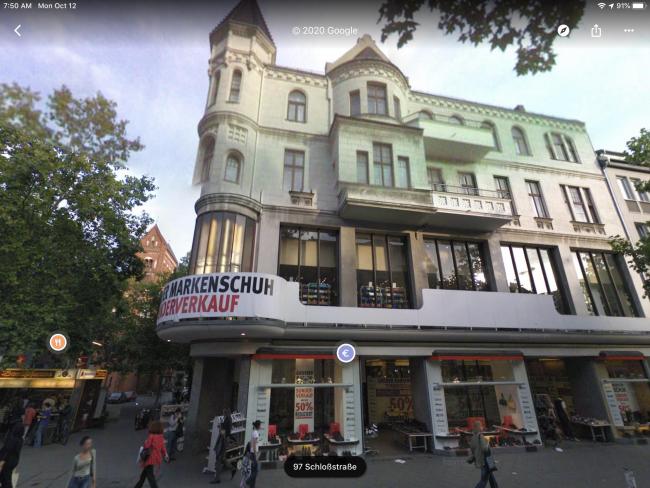The Kaufhaus in Google Streetview in 2020
Return to the Kaufhaus in 2001
Sue and her husband were immensely grateful to be permitted to book round the former family apartment at the time of their visit to Berlin with Peter and Reike Nash in June 2001 by Dr H Lazar a surgeon, who lived there at the time. Indeed, Dr Lazar was intrigued to learn more of the apartment’s history
The Schlossstrasse side of the L-sgaped building in 2001 remains almost exactly as it had been, still very recognizable from the family photographs taken probably in 1937, just before it was sold.
As Ilse described it, on the left, from the entrance, the first bedroom with the balcony was Gerhard’s, with the Art Deco bedroom suite in green maple. Next to it was Rosa and Moritz’s room. Then came the dining room, would could seat thirty-six and for which the family still has most of the 36 piece gold rimmed white dinner service used there. Next the study with its safe, then the drawing room with its archway to the Ercker, where had stood the grand piano draped in a blue silk cloth.
On the other side, overlooking the glazed roof garden to the back was the maid’s bedroom. Nanny Liselotte and Nurse Emmy also had their own rooms.Somewhere presumably must also have been Susies’s bedroom. Another big bedroom, which also overlooked the glazed roof garden was for a time occupied by Werner and Emma Prager, before they left Berlin for Rome. In Ilse's time, the hallway had been papered with English wallpaper with roses and red upholstered furniture for seating in the corridor.
Amazingly, the original Art Nouveau glass in the screens and in some of the windows of the apartment still remains intact even now. The bathroom still contains the original high-sided concrete, Art Nouveau ceramic tiled bath. The kitchen, which leads out to the roof garden also still has the original Art Nouveau ceramic tiles, but, in here, the decorative ties have been painted over by the present occupant’s wife. The study has lost its fireplace.
The immense drawing room remains, still with its cosy Erker and its window seat within the bay of the decorative tower, which clings to the corner of the building, although the panelling and wood-caring in the archway of the Erker had been removed prior to the Lazars’ occupation.

